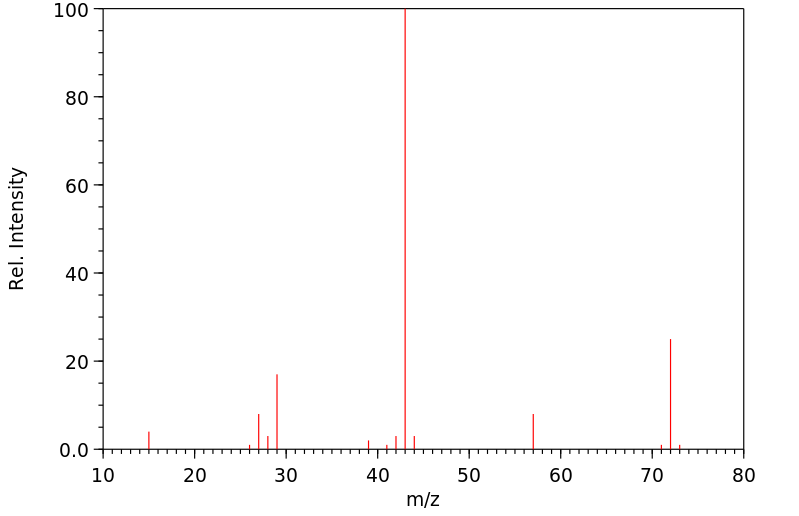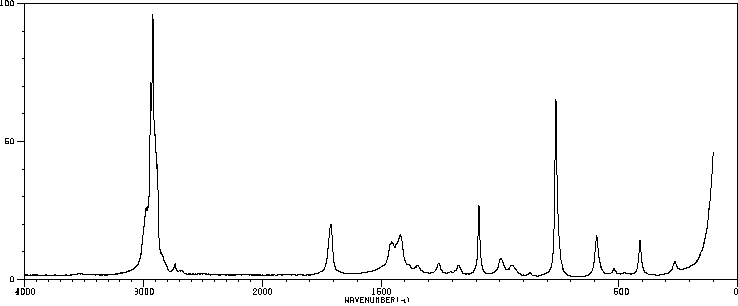丁酮 | 78-93-3
-
物化性质
-
计算性质
-
ADMET
-
安全信息
-
SDS
-
制备方法与用途
-
上下游信息
-
文献信息
-
表征谱图
-
同类化合物
-
相关功能分类
-
相关结构分类
物化性质
-
稳定性/保质期:
-
化学性质:丁酮由于具有羰基及与羰基相邻接的活泼氢,因此容易发生各种反应。它可与盐酸或氢氧化钠一起加热发生缩合,生成3,4-二甲基-3-己烯-2-酮或3-甲基-3-庚烯-5-酮。长时间受日光照射时,会生成乙烷、乙酸及缩合产物等物质。用硝酸氧化时生成联乙酰;使用铬酸等强氧化剂氧化时则生成乙酸。丁酮对热相对稳定,在超过500℃的高温下热裂解可生成烯酮或甲基烯酮。与脂肪族或芳香族醛缩合时,会生成高分子量的酮、环状化合物、缩酮及树脂等物质。例如,在氢氧化钠存在下与甲醛缩合首先生成2-甲基-1-丁醇-3-酮,接着脱水生成甲基异丙烯基酮。该化合物在日光或紫外光照射下会发生树脂化反应;若与苯酚缩合,则会生成2,2-双(4-羟基苯基)丁烷。在碱性催化剂存在下,与脂肪族酯反应可生成β-二酮;而在酸性条件下与酸酐作用则发生酰化反应,生成β-二酮。此外,它还能与氰化氢反应生成氰醇,与氨反应生成酮基哌啶衍生物。丁酮的α-氢原子容易被卤素取代生成各种卤代酮,例如与氯作用可生成3-氯-2-丁酮;与2,4-二硝基苯肼作用会生成黄色的2,4-二硝基苯腙(熔点115℃)。
-
稳定性:丁酮较为稳定。
-
禁配物:丁酮应避免接触强氧化剂、碱类及强还原剂。
-
聚合危害:丁酮不会发生聚合反应。
-
计算性质
-
辛醇/水分配系数(LogP):0.3
-
重原子数:5
-
可旋转键数:1
-
环数:0.0
-
sp3杂化的碳原子比例:0.75
-
拓扑面积:17.1
-
氢给体数:0
-
氢受体数:1
ADMET
制备方法与用途
制备丁酮的方法主要分为气相脱氢和液相脱氢两种。
气相脱氢法液相脱氢的工艺因其较低的反应温度和能耗、较高的产率以及较长的催化剂寿命而被广泛采用。此外,分离过程也更为简单。
丁烷液相氧化法- 主要产物是乙酸,同时副产丁酮(约占乙酸产量的16%)。
- 反应条件:温度为150~225℃,压力4.0~8.0MPa。例如美国联合碳化物公司在1976年用此法生产了22.6万吨乙酸,同时获得了3.6万吨的副产丁酮。
- 应用情况:目前在美国约有20%的丁酮是通过这种方法制备的。
- 使用氯化钯/氯化铜溶液作为催化剂,在90~120℃,压力为1.0~2.0MPa下进行反应。
- 转化率和收率:丁烯转化率约95%,丁酮收率约为88%。通过蒸馏等方法提纯得到成品。
- 缺点:设备易腐蚀,需要使用重金属催化剂。
- 正丁烯与苯经过烃化生成异丁苯。
- 然后在酸性条件下氧化生成过氧化氢异丁苯,最后通过酸分解制备丁酮和苯酚。
- 反应条件:苯烃化时,温度为50~70℃;异丁基苯液相氧化时,在110~130℃,压力0.1~0.49MPa下进行。随后在20~60℃下提浓氧化液。
- 优势:此法工艺设备腐蚀轻、反应条件温和,有利于工业化生产。
制备丁酮的方法主要包括气相脱氢和液相脱氢两种方式:
气相脱氢使用锌铜合金或氧化锌作为催化剂,在400~500℃常压条件下进行。
液相脱氢使用兰尼镍或亚铬酸铜为催化剂,反应温度150℃。此方法成本低、产率高且分离简单。
此外,还可以通过丁烷液相氧化法(互克尔法)和异丁苯法来制备:
总之,丁酮可以通过多种途径合成,每种方法都有其特点及适用场景。
上下游信息
-
上游原料
中文名称 英文名称 CAS号 化学式 分子量 3-戊酮 pentan-3-one 96-22-0 C5H10O 86.1338 2,3-丁二酮 dimethylglyoxal 431-03-8 C4H6O2 86.0904 环丁酮 cyclobutanone 1191-95-3 C4H6O 70.091 正丁醛 butyraldehyde 123-72-8 C4H8O 72.1069 丙酮 acetone 67-64-1 C3H6O 58.08 丙醛 propionaldehyde 123-38-6 C3H6O 58.08 3-己酮 n-hexan-3-one 589-38-8 C6H12O 100.161 正戊醛 pentanal 110-62-3 C5H10O 86.1338 1-羟基-2-丁酮 1-Hydroxy-2-butanone 5077-67-8 C4H8O2 88.1063 溴丁酮 1-Bromo-2-butanone 816-40-0 C4H7BrO 151.003 环戊酮 cyclopentanone 120-92-3 C5H8O 84.1179 - 1
- 2
-
下游产品
中文名称 英文名称 CAS号 化学式 分子量 3-戊酮 pentan-3-one 96-22-0 C5H10O 86.1338 2,3-丁二酮 dimethylglyoxal 431-03-8 C4H6O2 86.0904 乙酰乙醛 3-oxobutyraldehyde 625-34-3 C4H6O2 86.0904 2-戊酮 2-Pentanone 107-87-9 C5H10O 86.1338 正丁醛 butyraldehyde 123-72-8 C4H8O 72.1069 2-氧代丁醛 ethylglyoxal 4417-81-6 C4H6O2 86.0904 3-甲基-2-丁酮 3-methyl-butan-2-one 563-80-4 C5H10O 86.1338 丙酮 acetone 67-64-1 C3H6O 58.08 丙酮醛 2-oxopropanal 78-98-8 C3H4O2 72.0636 4-溴丁烷-2-酮 bromomethyl acetone 28509-46-8 C4H7BrO 151.003 3-己酮 n-hexan-3-one 589-38-8 C6H12O 100.161 1-戊烯-3-酮 4-penten-3-one 1629-58-9 C5H8O 84.1179 1-氯丁酮 1-chlorobutan-2-one 616-27-3 C4H7ClO 106.552 1-羟基-2-丁酮 1-Hydroxy-2-butanone 5077-67-8 C4H8O2 88.1063 溴丁酮 1-Bromo-2-butanone 816-40-0 C4H7BrO 151.003 —— 1,3-pentanedione 623-38-1 C5H8O2 100.117 1-碘-2-丁酮 1-iodo-2-butanone 78389-71-6 C4H7IO 198.003 环戊酮 cyclopentanone 120-92-3 C5H8O 84.1179 - 1
- 2
反应信息
-
作为反应物:参考文献:名称:Hurd, Journal of the American Chemical Society, 1923, vol. 45, p. 3099摘要:DOI:
-
作为产物:描述:参考文献:名称:有机硒催化的氧化C═C键裂解:相对绿色氧化的烯烃与过氧化氢成羰基化合物。摘要:通过有机硒催化的烯烃在乙醇中与过氧化氢的氧化反应,可以实现烯烃的相对绿色氧化C═C键裂解,从而在相对温和的条件下提供羰基化合物。它是有机硒催化烯烃氧化的一种新的反应方式,在很大程度上促进了有机硒催化领域的发展。DOI:10.1021/acs.joc.7b01245
-
作为试剂:描述:在 tris-(dibenzylideneacetone)dipalladium(0) 、 potassium chloride 、 2-(di-butylphosphino)3,6-dimethoxy-2',4',6'-triisopropylbiphenyl 、 丁酮 作用下, 以 甲苯 为溶剂, 以84 %的产率得到4,5-二氢-2-(4-氯苯基)噻唑参考文献:名称:使用香草醇氧化酶从 4-羟基苯甲醛化学酶法合成 2-芳基噻唑啉摘要:在香草醇氧化酶(VAO)存在下,通过自发缩合反应,由 4-羟基苯甲醛和氨基硫醇一锅合成 2-芳基噻唑啉,然后优先对原位生成的 CN 键进行酶促氧化(相对于其他竞争官能团) 。该生物催化剂表现出良好的底物耐受性,并且可以对酶产物进行化学修饰以扩大结构多样性。DOI:10.1002/anie.202405833
文献信息
-
Separate Sets of Mutations Enhance Activity and Substrate Scope of Amine Dehydrogenase作者:Robert D. Franklin、Conner J. Mount、Bettina R. Bommarius、Andreas S. BommariusDOI:10.1002/cctc.201902364日期:2020.5.7average of 2.5‐fold higher activity toward aliphatic ketones and an 8.0 °C increase in melting temperature. L‐AmDH‐TV did not show significant changes in relative activity for different substrates. In contrast, L39A, L39G, A112G, and T133G in varied combinations added to L‐AmDH‐TV changed the shape of the substrate binding pocket. L‐AmDH‐TV was not active on ketones larger than 2‐hexanone. L39A and L39G
-
Amino acid/zwitterion equilibria II: vibrational and NMR studies of substituted thiazolidine-4-carboxylic acids作者:H. E. Howard-Lock、C. J. L. Lock、M. L. MartinsDOI:10.1139/v91-252日期:1991.11.1
Infrared and Raman spectra (4000–100 cm) of solid samples of seven different 2-phenyl-, N-benzoyl-, and 2-ethyl-2 methyl derivatives of L-cysteine and D-penicillamine have been observed and assigned. Proton and 13C nuclear magnetic resonance spectra for the compounds have also been measured. Amino acid/zwitterion equilibria are discussed with reference to pK values and the vibrational spectra. Key words: amino acid/zwitterion equilibria, thiazolidine carboxylic acids.
-
A Route to “all-cis” 2-Methyl-6-Substituted Piperidin-3-ol Alkaloids from syn-(2R,1′S)-2-(1-Dibenzylaminomethyl)epoxide: Rapid Total Synthesis of (+)-Deoxocassine作者:Pierre-Yves Géant、Jean Martínez、Xavier J. Salom-RoigDOI:10.1002/ejoc.201101333日期:2012.1to the synthesis of two cis-2-methyl-6-substituted piperidin-3-ols is described. syn-(2R,1′S)-2-(1-Dibenzylaminomethyl) epoxide (13) was used as common building block. The key step involved oxirane ring opening of 13 by the nucleophilic lithium aza-enolate of hydrazones 12a and 12b. Subsequent hydrazone hydrolysis and intramolecular reductive amination afforded the alkaloid (+)-deoxocassine and a new
-
A simple and direct method for converting thioamides into thioesters作者:David C Harrowven、Matthew C Lucas、Peter D HowesDOI:10.1016/s0040-4020(98)01096-5日期:1999.1Thioamides may be transformed into thioesters through the simple expedient of warming them in an aqueous THF solution containing an alkylating agent. Reactions proceed in high yield and are amenable to multi-gram scale.
-
Autoxidation/Aldol Tandem Reaction of 2-Oxindoles with Ketones: A Green Approach for the Synthesis of 3-Hydroxy-2-Oxindoles作者:Qing-Bao Zhang、Wen-Liang Jia、Yong-Liang Ban、Yong Zheng、Qiang Liu、Li-Zhu WuDOI:10.1002/chem.201504282日期:2016.2.18In the presence of tetrabutylammonium fluoride and molecular sieves (MS) 4 Å in DMF, an efficient autoxidation reaction of 2‐oxindoles with ketones under air at room temperature has been developed. This approach may provide a green, practical, and metal‐free protocol for a wide range of biologically important 3‐hydroxy‐3‐(2‐oxo‐alkyl)‐2‐oxindoles.
表征谱图
-
氢谱1HNMR
-
质谱MS
-
碳谱13CNMR
-
红外IR
-
拉曼Raman
-
峰位数据
-
峰位匹配
-
表征信息











